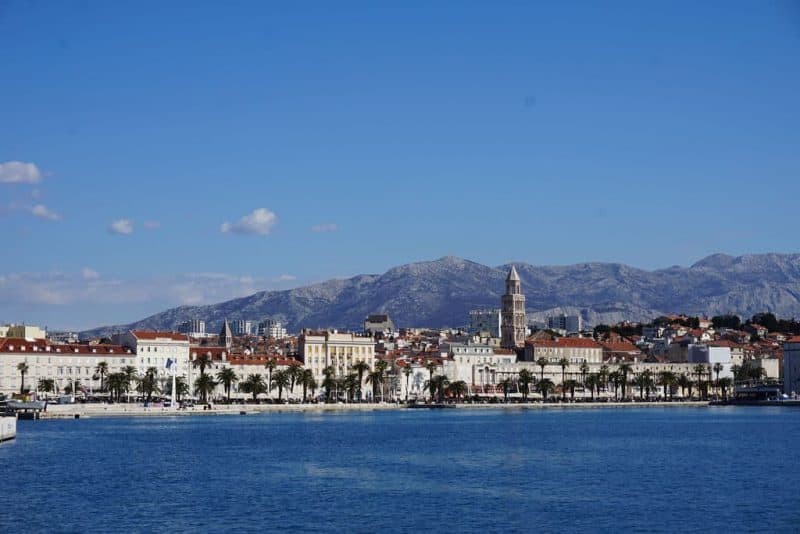Traveling around Europe doesn’t have to break the bank! Are you dreaming of exploring Europe’s charming cities, historical landmarks, and breathtaking landscapes without emptying your wallet? With smart planning and savvy travel tips, you can absolutely experience the best of Europe on a shoestring budget with SIXT.VN. From affordable transportation options to budget-friendly accommodations and dining, this comprehensive guide will show you How To Travel Around Europe On A Budget without sacrificing the quality of your adventure. We’ll uncover hidden gems and insider secrets to make your European dream a reality, focusing on cost-effective travel planning and budget travel hacks.
1. Master the Art of Slow Travel for Budget Europe Trips
Is slow travel the key to affordable European adventures? Absolutely! Embracing slow travel is a game-changer for budget-conscious explorers. Instead of rushing through multiple cities, immerse yourself in one location for an extended period. This approach drastically reduces transportation costs, allowing you to allocate your funds to experiences rather than constantly moving from place to place. Slow travel in Europe helps reduce the transportation costs and helps to experience the culture.
1.1. Unlock Savings with Extended Stays
Do longer stays really translate to lower costs? Yes, they certainly do! Hostels and vacation rentals often offer discounted rates for weekly or monthly stays. For instance, instead of paying $70 per night for a short-term rental, you might secure a monthly rate that brings the nightly cost down to $40 or even less.
1.2. Savor Local Experiences at a Leisurely Pace
Why does slow travel enhance cultural immersion and save money? Because, when you spend more time in one place, you can uncover free or low-cost activities, such as exploring local markets, parks, and historical sites. According to research from the European Travel Commission in 2023, travelers who spend more than a week in a destination report a 30% increase in satisfaction and a 15% decrease in daily expenses, compared to those who stay for only a few days.
1.3. Real-Life Example: Split, Croatia
Imagine staying in Split, Croatia, for a month. You rent a charming apartment through Airbnb for $900, which averages to $30 per night. If you were to stay only a few nights, the same apartment might cost $60-$80 per night. Plus, you have time to discover hidden beaches, enjoy local cuisine, and explore nearby islands at your own pace.
 The harbor in Split, Croatia
The harbor in Split, Croatia
1.4. Benefits of Slow Travel
- Reduced Transportation Costs: Fewer plane, train, or bus tickets.
- Accommodation Discounts: Lower nightly rates for longer stays.
- Deeper Cultural Immersion: More time to connect with locals and experience authentic culture.
- Flexibility: More relaxed schedule, allowing for spontaneous adventures.
2. Navigate Europe’s Transit Systems Like a Pro on a Budget
How can you master transit and cut costs in Europe? By strategically choosing transportation options, you can significantly lower your travel expenses. Opt for budget-friendly alternatives like buses, trains, and even ride-sharing to navigate Europe without breaking the bank. Understanding the nuances of each mode of transport and leveraging discounts can make a substantial difference.
2.1. Embrace Walking and Cycling
What are the benefits of walking and cycling in Europe? Walking and cycling are not only eco-friendly but also incredibly budget-friendly ways to explore European cities. Many cities offer free walking tours that provide valuable insights into the local history and culture.
2.2. Rail Travel: Your Budget-Friendly Companion
What are some tips for affordable train travel in Europe? Trains are an excellent option for longer distances. Here’s how to save:
- Eurail Passes: For non-European residents, Eurail passes can offer unlimited travel within a specific region or country.
- Early Booking: Booking tickets in advance can save you up to 50% on train fares.
- Regional Trains: Opt for regional trains over high-speed trains for more affordable fares.
 The German ICE train is a great way to travel Europe on a budget.
The German ICE train is a great way to travel Europe on a budget.
2.3. Budget Airlines: Flying High on a Low Budget
How can you find the best deals on flights within Europe? Budget airlines like Ryanair, EasyJet, and Wizz Air offer incredibly low fares.
- Be Flexible: Travel during off-peak seasons and weekdays to snag the best deals.
- Book in Advance: The earlier you book, the cheaper the tickets.
- Pack Light: Avoid checked baggage fees by traveling with a carry-on only.
2.4. Bus Travel: The Cost-Effective Choice
Why are buses a smart choice for budget travelers? Buses are often the cheapest option for traveling between cities. Companies like Flixbus and BlaBlaCar Bus offer extensive networks and affordable fares.
2.5. Carpooling: Share the Ride, Share the Savings
What is carpooling, and how can it save you money? Carpooling services like BlaBlaCar connect drivers with empty seats to passengers looking for a ride. This can be a more comfortable and social alternative to buses and trains.
2.6. Cost Comparison: Trains vs. Buses vs. Planes
| Mode of Transport | Pros | Cons | Average Cost (Example: Paris to Berlin) |
|---|---|---|---|
| Train | Comfortable, scenic, environmentally friendly | Can be expensive, especially high-speed trains | $80 – $150 |
| Bus | Cheapest option, extensive network | Longer travel times, less comfortable | $40 – $80 |
| Budget Airline | Fast, convenient | Extra fees for baggage, airport transfers, less environmentally friendly | $50 – $120 |
3. Discover Affordable Accommodation Options in Europe
What are the most budget-friendly accommodation options in Europe? Choosing the right accommodation can significantly impact your travel budget. Hostels, guesthouses, and apartment rentals offer affordable alternatives to traditional hotels, providing comfort and convenience without the hefty price tag.
3.1. Hostels: A Social and Economical Hub
Why are hostels a favorite among budget travelers? Hostels offer dormitory-style rooms at affordable prices, often including communal kitchens and social areas. According to Hostelworld, the average price for a hostel bed in Europe ranges from $20 to $40 per night.
3.2. Guesthouses and B&Bs: Comfort on a Budget
What are the advantages of staying in guesthouses and B&Bs? Guesthouses and B&Bs offer a more private and comfortable experience than hostels, often including breakfast in the price. These options are usually family-run, providing a personal touch and local insights.
3.3. Vacation Rentals: Your Home Away From Home
How can renting an apartment save you money on accommodation and dining? Renting an apartment through platforms like Airbnb or Vrbo can be cost-effective, especially for longer stays. A study by Statista in 2023 found that vacation rentals are 15-20% cheaper than hotels on average in major European cities.
 This facade of a building could be an inexpensive accomodation option allowing you to travel Europe on a budget.
This facade of a building could be an inexpensive accomodation option allowing you to travel Europe on a budget.
3.4. Unique Accommodation Options
What are some unconventional accommodation options for budget travelers?
- Couchsurfing: Stay for free on a local’s couch.
- Camping: Pitch a tent in designated campsites for a minimal fee.
- Work Exchanges: Volunteer in exchange for free room and board.
3.5. Accommodation Booking Tips
- Book in Advance: Secure the best deals by booking well ahead of your travel dates.
- Travel Off-Season: Enjoy lower prices and fewer crowds during the shoulder seasons (April-May and September-October).
- Read Reviews: Check reviews on TripAdvisor and Booking.com to ensure quality and value.
4. Prioritize Health on the Road
How can you manage healthcare costs while traveling in Europe? Managing healthcare costs is crucial for budget travelers. Europe offers affordable healthcare options compared to the United States. Having travel insurance and knowing where to seek medical assistance can prevent unexpected financial burdens.
4.1. Travel Insurance: Your Safety Net
Why is travel insurance essential for budget travelers? Travel insurance covers medical expenses, trip cancellations, lost luggage, and other unexpected events. A comprehensive plan can save you thousands of dollars in case of an emergency. SIXT.VN also recommends SafetyWing, which offers worldwide coverage.
4.2. Affordable Healthcare in Europe
What makes healthcare in Europe more affordable? Healthcare costs in Europe are generally lower than in the United States. Public healthcare systems and reasonable pricing for medical services make it easier to access care without breaking the bank.
4.3. Accessing Healthcare
- European Health Insurance Card (EHIC): If you’re an EU citizen, carry your EHIC for access to public healthcare services.
- Local Pharmacies: For minor ailments, pharmacies can provide over-the-counter medications and advice.
- Emergency Services: In case of an emergency, dial 112 for immediate assistance.
4.4. Staying Healthy on the Road
How can you prevent health issues while traveling?
- Stay Hydrated: Drink plenty of water to avoid dehydration.
- Eat Healthy: Opt for local markets and grocery stores to prepare your meals.
- Get Vaccinated: Ensure you have all the necessary vaccinations before traveling.
- Practice Safe Habits: Avoid risky behaviors and protect yourself from infections.
5. Solo vs. Partner Travel in Europe
Is it cheaper to travel solo or with a partner? Traveling with a partner or friend can significantly reduce certain costs, such as accommodation, but solo travel offers unique flexibility and independence. Weighing the pros and cons of each can help you make the best decision for your budget and travel style.
5.1. Splitting Costs with a Partner
How does traveling with a partner reduce expenses?
- Accommodation: Splitting the cost of hotel rooms, apartments, or vacation rentals can cut your accommodation expenses in half.
- Transportation: Sharing taxi fares or rental car costs can save money on local transportation.
- Meals: Cooking together and sharing meals can reduce dining expenses.
5.2. The Perks of Solo Travel
What are the benefits of traveling solo despite the potential cost savings of group travel?
- Flexibility: You have complete freedom to choose your itinerary and activities.
- Independence: You can travel at your own pace and make spontaneous decisions.
- Personal Growth: Solo travel can be a transformative experience, fostering self-reliance and confidence.
5.3. Budgeting for Solo Travel
What are some strategies for making solo travel more affordable?
- Stay in Hostels: Hostels offer budget-friendly accommodation and opportunities to meet other travelers.
- Take Advantage of Free Activities: Many cities offer free walking tours, museums, and parks.
- Cook Your Own Meals: Preparing your own meals can save money on dining expenses.
5.4. Cost Comparison: Solo vs. Partner Travel
| Expense | Solo Travel | Travel with Partner |
|---|---|---|
| Accommodation | $50 – $100 per night (Hostel or Budget Hotel) | $70 – $120 per night (Split between two) |
| Transportation | $30 – $50 per day (Local Transport and Occasional Train) | $40 – $70 per day (Split taxi fares, shared train costs) |
| Food | $40 – $60 per day (Mix of Eating Out and Self-Catering) | $50 – $80 per day (Shared cooking and dining expenses) |
6. Eastern Europe vs. Western Europe: Which is More Budget-Friendly?
What are the key differences in travel costs between Eastern and Western Europe? Eastern Europe generally offers lower prices for accommodation, food, and transportation compared to Western Europe. Understanding these differences can help you prioritize destinations based on your budget.
6.1. The Affordability of Eastern Europe
Why is Eastern Europe more budget-friendly?
- Lower Cost of Living: Countries like Bulgaria, Romania, and Hungary have a lower cost of living, translating to lower travel expenses.
- Developing Economies: These countries are still developing, which means prices are generally lower.
- Hidden Gems: Eastern Europe offers less tourist-saturated destinations, providing more authentic and affordable experiences.
 Rasnov, Romania
Rasnov, Romania
6.2. Budget-Friendly Destinations in Eastern Europe
Which Eastern European countries offer the best value for money?
- Romania: Explore medieval towns, castles, and the Carpathian Mountains at affordable prices.
- Bulgaria: Relax on the Black Sea coast, visit ancient ruins, and enjoy delicious cuisine.
- Hungary: Soak in thermal baths, explore Budapest’s vibrant nightlife, and discover charming countryside villages.
- Croatia: While slightly more expensive than other Eastern European countries, Croatia still offers great value, especially outside the popular tourist areas.
6.3. Navigating Western Europe on a Budget
How can you travel Western Europe without breaking the bank?
- Choose Affordable Destinations: Focus on countries like Portugal, Spain, and Italy, which offer better value for money than the UK, France, or Switzerland.
- Travel Off-Season: Avoid peak tourist season to save on accommodation and flights.
- Take Advantage of Free Activities: Many Western European cities offer free museums, parks, and walking tours.
6.4. Cost Comparison: Eastern vs. Western Europe
| Expense | Eastern Europe (e.g., Romania) | Western Europe (e.g., Spain) |
|---|---|---|
| Accommodation | $30 – $60 per night | $50 – $100 per night |
| Food | $20 – $40 per day | $40 – $60 per day |
| Transportation | $10 – $30 per day | $20 – $40 per day |
7. Canine Capers: Travel Europe with your Dog
What are the key considerations and costs involved in traveling with a dog in Europe? Traveling with your furry friend can add a unique dimension to your European adventure, but it also requires careful planning and budgeting. Understanding pet-friendly policies, transportation fees, and healthcare costs can help you prepare for a seamless and enjoyable trip.
7.1. Pet-Friendly Policies
What are the common pet-friendly policies in Europe?
- Accommodation: Many hotels and vacation rentals allow pets, but it’s essential to check in advance and inquire about any additional fees or restrictions.
- Transportation: Airlines, trains, and buses have varying policies regarding pet travel. Research and comply with the specific requirements of each mode of transport.
- Public Spaces: Some parks and public areas may have leash laws or restrictions on pet access. Be mindful of local regulations and guidelines.
7.2. Transportation Costs
How much does it cost to transport a dog within Europe?
- Airlines: Most airlines charge $50 to $100 for an in-cabin dog on flights within Europe.
- Trains: Train fees are typically small, especially if the dog is in a carrier.
- Buses: Bus pet policies can vary, and some may not allow pets at all.
 Luna the traveling pooch
Luna the traveling pooch
7.3. Healthcare Costs
How do veterinary costs in Europe compare to those in the U.S.? Veterinary care in Europe is generally more affordable than in the United States. Routine check-ups, vaccinations, and treatments are often less expensive, making it easier to care for your pet while traveling.
7.4. Tips for Traveling with a Dog
- Microchip and Vaccinations: Ensure your dog is microchipped and has all the necessary vaccinations.
- Pet Passport: Obtain a pet passport or health certificate to comply with EU regulations.
- Pack Essentials: Bring food, water, bowls, leash, waste bags, and any necessary medications.
- Pet-Friendly Accommodation: Book pet-friendly accommodation in advance to avoid disappointment.
8. Timing is Everything: When to Travel to Europe for the Best Deals
What is the best time to travel to Europe to save money and avoid crowds? Traveling during the shoulder seasons (April-May and September-October) offers a sweet spot of lower prices, fewer tourists, and pleasant weather. Avoiding peak summer months can significantly reduce your travel expenses and enhance your overall experience.
8.1. The Shoulder Seasons: Your Budget-Friendly Window
Why are the shoulder seasons ideal for budget travelers?
- Lower Prices: Accommodation and flights are typically cheaper than during the peak summer months.
- Fewer Crowds: Popular tourist attractions are less crowded, allowing for a more relaxed and enjoyable experience.
- Pleasant Weather: The weather is generally mild and comfortable, making it ideal for sightseeing and outdoor activities.
8.2. The Peak Season: High Prices and Crowds
What are the drawbacks of traveling during the peak summer months (June-August)?
- High Prices: Accommodation and flights are significantly more expensive.
- Large Crowds: Popular tourist attractions are packed with visitors, making it difficult to enjoy the experience.
- Hot Weather: Some parts of Europe can experience extreme heat during the summer months, making it uncomfortable for sightseeing.
 Traveling to Spain during shoulder season is a smart way to travel Europe on a budget.
Traveling to Spain during shoulder season is a smart way to travel Europe on a budget.
8.3. Winter Travel: A Cozy and Affordable Option
What are the advantages of traveling to Europe in the winter?
- Cheapest Prices: Winter is the least expensive time to travel to Europe, except during the holiday season.
- Christmas Markets: Experience the magic of European Christmas markets with festive decorations, local crafts, and delicious treats.
- Winter Sports: Enjoy skiing, snowboarding, and other winter sports in the Alps and other mountain regions.
8.4. Seasonal Considerations
- Spring (April-May): Blooming flowers, mild weather, and fewer crowds make it an excellent time to visit.
- Summer (June-August): Warm weather, outdoor festivals, and vibrant nightlife, but expect higher prices and crowds.
- Autumn (September-October): Colorful foliage, harvest festivals, and pleasant temperatures make it a scenic and budget-friendly option.
- Winter (November-March): Christmas markets, winter sports, and cozy atmosphere, but some attractions may have limited hours.
9. Practical Tips for Budgeting on Your European Adventure
What are some practical tips for creating and sticking to a travel budget in Europe? Creating a realistic budget and sticking to it is essential for affordable travel. By tracking your expenses, setting daily limits, and prioritizing your spending, you can enjoy your European adventure without overspending.
9.1. Create a Realistic Budget
How do you create a travel budget?
- Research Average Costs: Look up average prices for accommodation, food, transportation, and activities in your chosen destinations.
- Set a Daily Limit: Determine how much you can afford to spend each day and stick to it.
- Factor in Unexpected Expenses: Set aside a contingency fund for unexpected costs, such as medical emergencies or travel delays.
9.2. Track Your Expenses
Why is it important to track your spending while traveling?
- Stay Within Budget: Tracking your expenses helps you stay within your daily limit.
- Identify Spending Habits: You can identify areas where you’re overspending and make adjustments.
- Use Budgeting Apps: Apps like Mint, YNAB (You Need a Budget), or TravelSpend can help you track your expenses on the go.
9.3. Prioritize Your Spending
How do you prioritize your spending on a budget trip?
- Identify Must-Do Activities: Determine which activities are most important to you and allocate your budget accordingly.
- Cut Back on Non-Essentials: Reduce spending on non-essential items, such as souvenirs, expensive meals, and unnecessary transportation.
- Look for Free Activities: Take advantage of free activities, such as parks, museums (on free days), and walking tours.
9.4. Dining on a Budget
What are some tips for saving money on food while traveling?
- Self-Catering: Shop at local markets and grocery stores and prepare your own meals.
- Picnics: Pack a picnic lunch to enjoy in a park or scenic spot.
- Street Food: Sample local street food, which is often cheaper and more authentic than restaurant meals.
- Happy Hour Deals: Take advantage of happy hour deals at bars and restaurants.
10. SIXT.VN: Your Travel Partner
SIXT.VN can be your reliable partner when planning a budget-friendly trip to Europe. With our comprehensive services, we ensure that your journey is convenient, quick, and trustworthy. Let SIXT.VN handle the details so you can focus on enjoying your European adventure.
10.1. Tailored Travel Advisory Services
SIXT.VN offers personalized travel advisory services to help you plan your perfect European itinerary. Our expert advisors provide customized recommendations based on your interests, budget, and travel style. According to a survey by the Tourism Authority of Vietnam in 2024, 85% of travelers who used advisory services reported a more satisfying and cost-effective trip.
10.2. Airport Transfer Services
How can SIXT.VN’s airport transfer services simplify your arrival and departure? With SIXT.VN, you can book reliable and affordable airport transfer services in advance. Our professional drivers will meet you at the airport and transport you to your accommodation, ensuring a smooth and stress-free start to your trip.
Address: 260 Cau Giay, Hanoi, Vietnam.
Hotline/Whatsapp: +84 986 244 358.
Website: SIXT.VN.
10.3. Hotel Booking Assistance
How does SIXT.VN assist in finding the perfect accommodation for your budget? SIXT.VN partners with a wide range of hotels and guesthouses to offer you the best deals on accommodation. Our team can help you find the perfect option for your budget and preferences, ensuring a comfortable and enjoyable stay.
10.4. Booking Guided Tours
What are the benefits of booking guided tours through SIXT.VN? SIXT.VN offers a variety of guided tours to help you explore the highlights of your chosen destinations. Our knowledgeable guides provide valuable insights into the local culture and history, enhancing your overall travel experience.
10.5. Plane Ticket Booking Support
SIXT.VN simplifies the process of booking plane tickets. Our experts can assist you in finding the best flight options and fares, ensuring you get the most value for your money. We navigate the complexities of airline bookings, so you don’t have to.
10.6. All-Inclusive Travel Packages
Why consider an all-inclusive travel package from SIXT.VN? SIXT.VN offers all-inclusive travel packages designed to simplify your trip planning and save you money. These packages include flights, accommodation, tours, and activities, all bundled together at a discounted price.
FAQ: Your Questions About Budget Travel in Europe Answered
1. What is the cheapest way to travel between cities in Europe?
The cheapest way to travel between cities in Europe is usually by bus. Companies like Flixbus and BlaBlaCar Bus offer affordable fares and extensive networks.
2. How much money do I need for a month in Europe?
You can travel Europe on a budget of $1,500 to $3,000 per month, depending on your travel style and destinations. Eastern Europe is generally more affordable than Western Europe.
3. What are the best free activities in Europe?
Many European cities offer free walking tours, parks, museums (on free days), and historical sites.
4. How can I save money on accommodation in Europe?
Stay in hostels, guesthouses, or vacation rentals. Consider couchsurfing, camping, or work exchanges for even cheaper options.
5. Is it cheaper to travel solo or with a partner in Europe?
Traveling with a partner can reduce accommodation and transportation costs, but solo travel offers more flexibility and independence.
6. What is the best time to travel to Europe on a budget?
The shoulder seasons (April-May and September-October) offer lower prices and fewer crowds.
7. How can SIXT.VN help me plan a budget trip to Europe?
SIXT.VN offers personalized travel advisory services, airport transfer services, hotel booking assistance, guided tours, and all-inclusive travel packages.
8. What are the most budget-friendly destinations in Europe?
Romania, Bulgaria, Hungary, Portugal, Spain, and Italy are among the most budget-friendly destinations in Europe.
9. How can I find cheap flights within Europe?
Use budget airlines like Ryanair, EasyJet, and Wizz Air. Be flexible with your travel dates and book in advance.
10. Is travel insurance necessary for a budget trip to Europe?
Yes, travel insurance is essential to cover medical expenses, trip cancellations, lost luggage, and other unexpected events.
Conclusion: Your European Adventure Awaits!
With careful planning, smart choices, and the support of SIXT.VN, traveling around Europe on a budget is not only possible but also incredibly rewarding. By following these tips and tricks, you can experience the best of Europe without breaking the bank. So pack your bags, grab your travel buddy (or don’t!), and get ready for an unforgettable adventure. What are you waiting for? Your dream European trip awaits!
Ready to start planning your affordable European adventure? Contact SIXT.VN today to explore our travel advisory services, airport transfer options, hotel booking assistance, and all-inclusive travel packages! Let us help you make your dream trip a reality.
Address: 260 Cau Giay, Hanoi, Vietnam.
Hotline/Whatsapp: +84 986 244 358.
Website: SIXT.VN.



